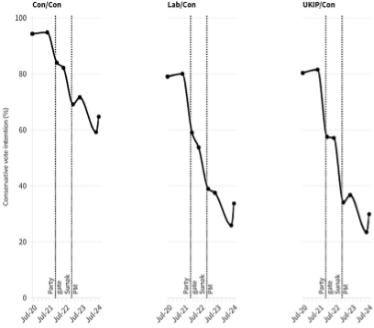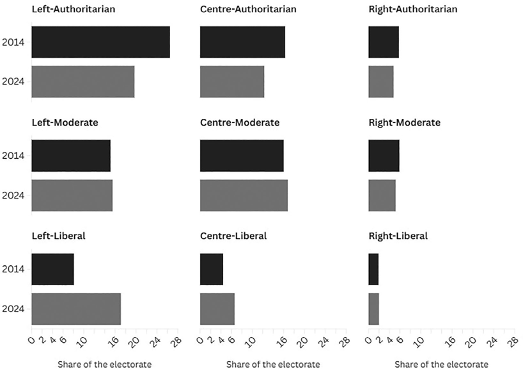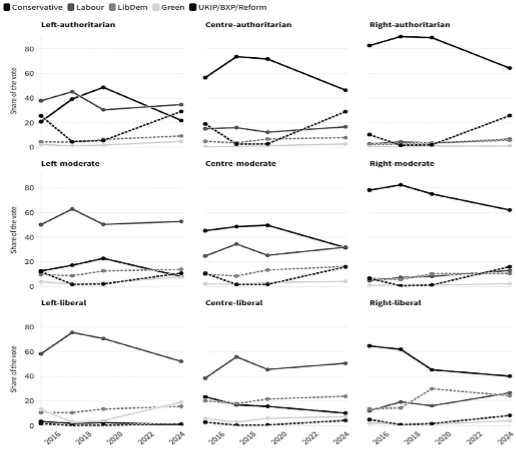| 7 mins read
The 2024 General Election was a ‘valence election’, based on the Conservative government’s competence, dominated by dissatisfaction with its handling of key issues like the NHS (76%) and immigration (78%). Public discontent reached record levels, with two-thirds believing the government did not deserve re-election, resulting in a 20 percentage point decline in vote share from 2019.
The Conservatives lost support to the Liberal Democrats, Reform UK, and Greens but Labour also saw defections to the Greens and independents, reflecting a fragmented electorate. The election’s outcome highlights the complexities of the current political landscape and the continued diversification of voter preferences.
The 2019 Conservative coalition
The Conservative Party’s 2019 victory was built on a fragile coalition, united under the promise to “get Brexit done.” This coalition brought together loyal Conservative voters, former Labour supporters, and those who had backed UKIP in 2015. However, holding such a diverse voter base together once Brexit was delivered was always going to be a challenge. Events during the 2019–2024 Parliament shattered this coalition more quickly than many anticipated.

Figure 1: Conservative Party share of the vote (intention) for 2019 Conservative voters by 2015 vote
Analysis of British Election Study Internet Panel (BESIP) data reveals the fragmentation of the 2019 Conservative coalition, which included loyal Conservatives (two-thirds), Labour-to-Conservative switchers (10%), and former UKIP voters (17%). As Figure 1 shows, by late 2022, scandals, economic turmoil and Boris Johnson’s resignation saw support plummet, especially among switchers and UKIP voters. Labour’s 2024 victory undoubtedly reflects Conservative losses, but its narrow vote share highlights growing electoral fragmentation, shaped by shifting values and an increasingly divided political landscape.
Values and the British Electorate
Values reflect what individuals see as desirable outcomes—what ought to be, rather than what is. They are more enduring than specific attitudes, akin to broad musical tastes rather than preferences for a single song. While values shape behaviour, their importance varies with circumstances; economic pressures often overshadow cultural concerns.
In Western democracies, political values are typically defined along two dimensions: state intervention in the economy and social issues, often termed the ‘liberal-authoritarian’ divide, which includes immigration and political trust. In Britain, these dimensions intersect, with economic and cultural divides combining to create key tensions driving voter preferences today.
Measuring Political Values
The BESIP measures two key value dimensions in British politics. The first, the "left-right" dimension, concerns economic justice and the distribution of resources and power. The second, labelled "liberal-authoritarian," focuses on authority, liberty, equality, and justice. While debate exists over the precise labelling of this second dimension, the BESIP prioritises authority and liberty, excluding issues like the environment or personal morality. These dimensions are uncorrelated, meaning a voter’s stance on one does not predict their position on the other.
Each dimension is assessed using five attitudinal statements, with respondents rating their agreement on a five-point scale. Responses are combined into 0–10 scales divided into left, centre, and right; liberal, moderate, and authoritarian.
Left-Right Statements
- Government should redistribute income from the wealthy to the less well-off.
- Big business benefits owners at workers’ expense.
- Ordinary people do not receive their fair share of wealth.
- There is one law for the rich and another for the poor.
- Management will exploit employees if possible.
Liberal-Authoritarian Statements
- Young people lack respect for traditional values.
- Censorship is necessary to uphold morality.
- Some crimes warrant the death penalty.
- Schools should teach obedience to authority.
- Lawbreakers should receive stiffer sentences.
Figure 2 suggests that gradual generational shifts toward liberal values have reshaped the electorate. In 2024, left-authoritarians (20%) and left-liberals (17%) were the largest groups, while right-liberals remained the smallest at just 2%.

Figure 2: Size of the values groups, 2014 and 2024
Values and voting in 2024
The 2024 election underscores the complex relationship between voters’ economic and social values and party competition. As Figure 3 shows, despite a sharp decline in support, the Conservatives remained the leading party among economically right-leaning groups, though these voters represent a small portion of the electorate. Labour, on the other hand, dominated economically left-leaning groups, highlighting the continued relevance of the traditional left-right divide.
However, voter preferences also aligned with the "new politics" dimension. The Liberal Democrats performed best among the most liberal groups, securing second place behind Labour among centre-liberal voters, while the Green Party took second place among the most liberal left-leaning groups. Reform UK dominated among authoritarian groups, placing second to Labour on the left and the Conservatives in the centre- and right-authoritarian groups. Among centre-moderate voters, Labour and the Conservatives were almost tied for first, with the Greens and Reform UK tied for third.
The Conservative collapse affected all groups, with voter shifts primarily driven by underlying values. Authoritarian voters swung largely to Reform UK, while moderate groups saw Labour gaining slightly more than Reform UK. Among the most liberal groups, Labour lost support to the Green Party, which gained around 15 percentage points.
The 2024 election highlighted both electorate fragmentation and deep Conservative losses, falling below 2015 levels. Labour surpassed the Conservatives among economically centrist voters, while Reform UK matched UKIP’s 2015 vote share in left-leaning groups. The election showcased familiar patterns but unprecedented Conservative failures, driven by chaotic leadership and declining trust.

Figure 3: Vote share at general election by values group, 2015–2024
Future Challenges
The political landscape of twenty-first century Britain is marked by fragmentation, creating challenges for all parties. While Labour benefits from favourable electoral geography, it faces public doubts about its capability, with over a quarter of voters expressing no confidence in any party. The Liberal Democrats depend on anti-Conservative sentiment but lack a clear independent appeal. For the Conservatives, rebuilding their fractured 2019 coalition hinges on restoring economic credibility and transitioning from a party voters reject to one they support. This fragmentation presents opportunities for smaller parties, like Green and Reform, and means major ones must craft cohesive coalitions by balancing economic and social values to navigate Britain’s evolving political mosaic.
Need help using Wiley? Click here for help using Wiley







